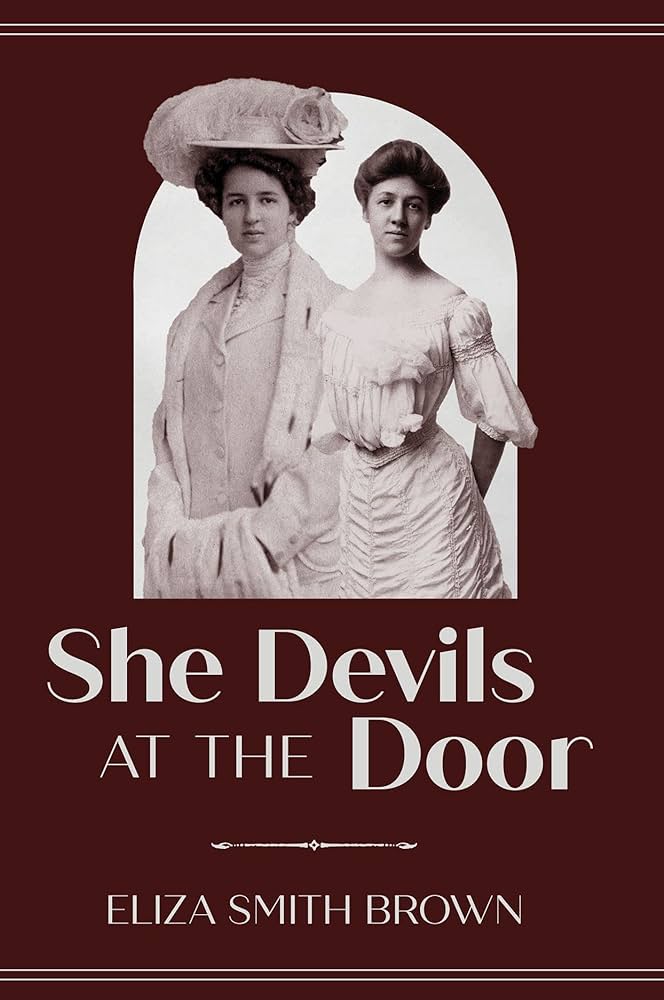Welcome to DU!
The truly grassroots left-of-center political community where regular people, not algorithms, drive the discussions and set the standards.
Join the community:
Create a free account
Support DU (and get rid of ads!):
Become a Star Member
Latest Breaking News
Editorials & Other Articles
General Discussion
The DU Lounge
All Forums
Issue Forums
Culture Forums
Alliance Forums
Region Forums
Support Forums
Help & Search
'She Devils at the Door': Women's Suffrage and Its Opposition
‘She Devils at the Door’: Women’s Suffrage and Its Opposition
PUBLISHED 3/25/2024 by Eliza Smith Brown
She Devils at the Door tells the true story of two formidable sisters, Lucy and Eliza Kennedy, who came of age in Gilded Age Pittsburgh, graduated from Vassar College, and became leaders of the suffrage movement. But they didn’t stop after women won the vote in 1920. Instead, they spent 40 years fighting corruption in local government. In an election year, and amidst our current climate of civic skulduggery, these two uncommon women bear the hallmarks of folk heroes, armed with sufficient moxie to battle the gritty, scandal-ridden political machine with tenacity and wit.

The following is an excerpt from She Devils at the Door, published by Carnegie Mellon University Press, depicting some of the women-led opposition to the women’s suffrage movement.
As the suffrage movement gathered momentum, those who would thwart it were rallying their own troops. The National Association Opposed to Woman Suffrage (NAOWS) had been organized in 1911, with the support of some wealthy women, some Catholic clergy, and the distilling and brewing industries, who had every reason to fear the influence of women. At a luncheon in New York, the group had declared that they would “follow the activities of the suffragists step by step.” With the movement gaining traction in Pennsylvania, New Jersey, Maryland, Virginia, Ohio, Oregon, Kansas, Missouri, Kentucky and New Hampshire, the anti-suffragists—or “antis”—would be kept running to try and keep up with the “suffs.” By the time of the first-round passage of the amendment in the state legislature, Lucy reported, “the opposition forces were now truly awake.”
In the wake of a January debate at Pittsburgh’s Twentieth Century Club, the antis launched a new organization and a strong presence in the city. Supported by the national movement, they called themselves “home conservationists” and maintained that they did not raise their daughters to be voters. With Julia Morgan Harding and Eliza D. Armstrong leading the charge, the Pittsburg Association Opposed to Women’s Suffrage waged a fierce battle of its own.
The group held its first meeting of 50 women on Feb. 12, 1912.
Their second meeting drew a hundred of the city’s most fashionable women. By November, they had 10,000 signatures against suffrage in Pennsylvania.
By the end of the decade, the National Association Opposed to Woman Suffrage would claim a total membership of 700,000.
The antis dismissed the suffragists and their activities as a “cult” and a “bluff.” They insisted that suffrage was a privilege, not a right; that it had not benefitted women in the states and countries where they had the ballot; that women in politics would be a menace to society and the home; that it would introduce more immigrant, Negro and immoral voices; that it would double the cost of elections; that the suffrage movement encouraged a state of neurotic unrest and hysteria; that women’s views were already adequately represented by their fathers, brothers, husbands and sons; that women could be more effective in advancing their interests “free and unfettered by political ties and obligations”; and that, quite simply, women did not want it.
“Indifference is a greater foe of the suffrage cause than the active manifestations of the anti-suffragists,” they argued. “We cannot have manly men unless we preserve womanly women.”
. . . .
A generation older than Lucy and most of her cohorts, Julia Morgan and Eliza Armstrong were unmarried women who righteously defended the sanctity of marriage and motherhood and the rightful place of women as being in the home. To Lucy, a happily married young mother, their arguments that suffrage would make women too masculine seemed particularly spurious. She predicted that woman suffrage would be “one of the great forces in the advance of civilization.” In 1912, when they began to go toe-to-toe with the women of the Equal Franchise Federation, Julia Morgan was 58 and Eliza Armstrong was 67. Lucy was 32. Eliza Armstrong would maintain her anti-suffrage stance until the day she died at the age of 90 in 1935.
https://msmagazine.com/2024/03/25/she-devils-at-the-door-womens-suffrage-opposition/
InfoView thread info, including edit history
TrashPut this thread in your Trash Can (My DU » Trash Can)
BookmarkAdd this thread to your Bookmarks (My DU » Bookmarks)
0 replies, 161 views
ShareGet links to this post and/or share on social media
AlertAlert this post for a rule violation
PowersThere are no powers you can use on this post
EditCannot edit other people's posts
ReplyReply to this post
EditCannot edit other people's posts
Rec (3)
ReplyReply to this post